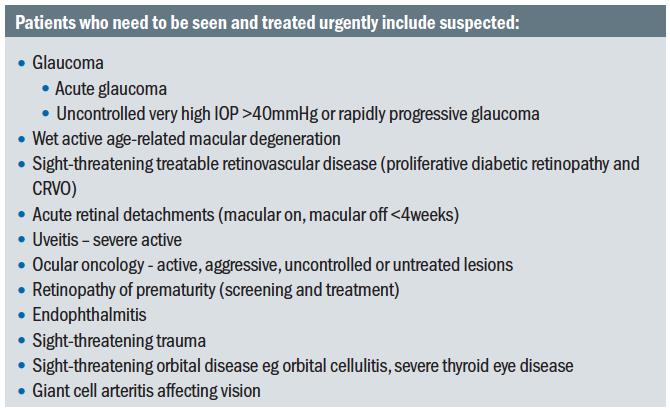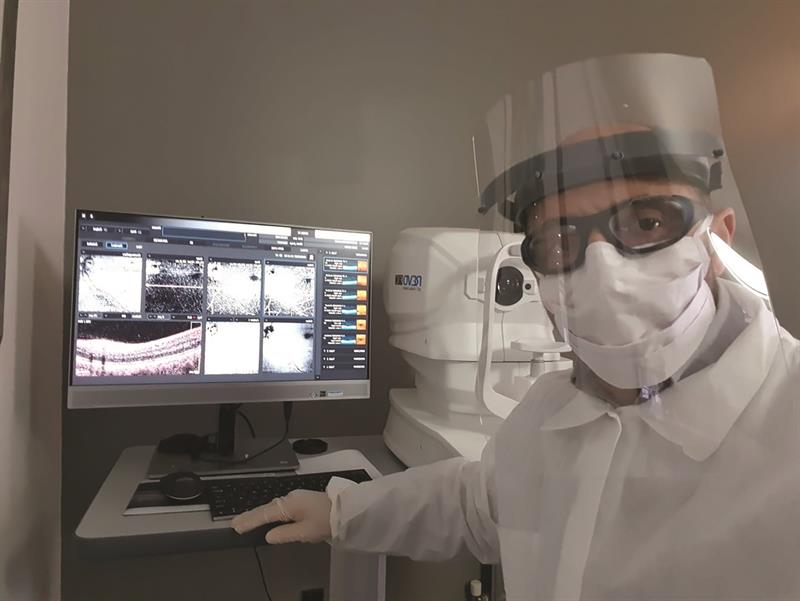
Handwashing Addendum
Following from last week’s CET on handwashing, Nick Atkins writes..’ a recent study1 evaluated the effectiveness of antiseptic hand rubbing (without water) with ethanol-based disinfectants compared with antiseptic handwashing (with water) against seasonal influenza A virus in the presence of dry and non-dry infectious mucous. It found that handwashing was most effective against both dry and non-dry infectious mucous, while the effectiveness of hand rubbing was greatly reduced until the infectious mucous adhering to the hands/fingers had completely dried. So, if hands cannot be properly dried between patients, antiseptic handwashing should be adopted to compensate for the weaknesses of antiseptic hand rubbing.’
Useful Resources
A useful link being used by general practitioners has been produced, and is updated daily, by the BMJ. Go to https://bestpractice.bmj.com/topics/en-gb/3000168/history-exam#keyFactors. The only ocular information of note is listed under uncommon diagnostic factors. It states, ‘Ocular manifestations consistent with conjunctivitis (conjunctival hyperaemia, chemosis, epiphora, and increased secretions) have been reported in 32% of patients in one case series. Manifestations are more frequent in patients with severe illness.’2
I guess there will soon appear more references supporting the link with conjunctivitis as a direct infection rather than a secondary opportunistic event. For example, a case study just out in the BJO3 looked at swabs taken from a COVID-19 patient also showing severe follicular conjunctivitis and concludes ‘SARS-CoV-2 is capable of causing ocular complications such as viral conjunctivitis in the middle phase of illness.’
Another excellent new resource is aimed at London-based GPs but with comprehensive guidance notes relevant to primary care all in one easily accessible place. Perfect for those of you looking to consolidate the many emails pinging out at the moment. Go to www.lmc.org.uk/coronavirus-covid-19.html.
Clinical Practice
The College of Optometrists continues to offer updated advice to optometrists. The latest at time of writing includes, ‘Consider referrals carefully. Non-urgent patients will not be seen by the hospital, so only refer patients with urgent conditions (see table 1).
 Table 1: Urgent referrals
Table 1: Urgent referrals
Also of interest, Optimed is generously making freely available its excellent software for the duration of the pandemic. This includes free access to the CAPTIV8 Share app allowing you to share medical and surgical animations through a mobile app to patients. I have already started circulating their excellent coronavirus animation (figure 1). As optometrist and boss Dr Trusit Dave says: ‘It will be particularly useful during triage consultations and face-to-face in order to reduce chair-time.’ Look out for guidance on how to set-up a remote video triage service available at www.optimed.co.uk/coronavirus-implementing-video-c... and also free animations on coronavirus for sharing on social media at; www.optimed.co.uk/helping-clinicians-through-the-coronavirus-crisis.
I also note that Optopol have unlocked their entire software suite allowing full remote access to their range of Revo OCT devices, though at least one suitably attired staff member will need to remain on site to let patients in and out of the practice (figure 2). As the Revo positions and focuses automatically, without the need for practitioner joystick control, full remote control by an external computer is now possible. Any suitable remote desk top software that is compatible with Windows 10 can capture and save data for remote analysis, minimising infection risk.
 Figure 2: Last man on site
Figure 2: Last man on site
Virus Update
After last week’s debate about the potential influence of BCG vaccination upon the spread of COVID-19, this week saw evidence published implying a direct correlation between morbidity and mortality and vitamin D mean levels (DOI; 10.21203/rs.3.rs- 21211/v1). Expect some calls for supplementation. More on this, and the influence of ethnicity and gender, next week.
References
- Hirose R et al. Situations leading to reduced effectiveness of current hand hygiene against infectious mucus from influenza virus-infected patients. mSphere.asm.org, 2019; Issue 4 Vol 5
- Wu P, Duan F, Luo C, et al. Characteristics of ocular findings of patients with coronavirus disease 2019 (COVID-19) in Hubei province, China. JAMA Ophthalmology, 2020 Mar 31
- Chen L, et al. Ocular manifestations of a hospitalised patient with confirmed 2019 novel coronavirus disease. British Journal of Ophthalmology, 2020; 0: 1–4.
